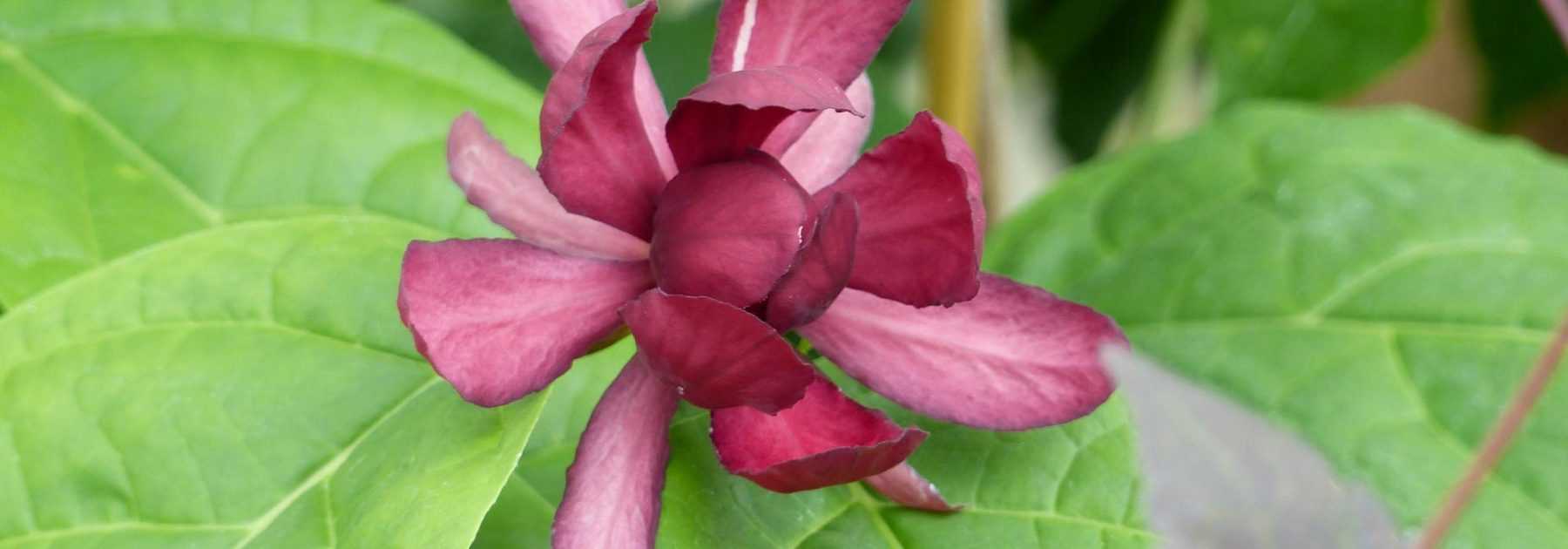
Calycanthus or Sweetshrub: Planting, Pruning and Care
Contents
The Calycanthus in a few words
- The anemone tree is a beautiful shrub with elegant flowers in late spring
- Its unique flowers emit a subtle strawberry fragrance
- Highly hardy (-20°C) and disease-resistant
- Fairly compact, reaching 2m in height within 5-6 years
- Easy to grow, requiring only sunshine to thrive
Our expert's word
Still too little known, the Calycanthus or Sweetshrub, also called the “Pompadour Tree”, is a shrub with a long and unique flowering period in spring and summer that deserves a prime spot in every garden. It starts flowering from a very young age!
From late spring and throughout summer, its flowers resembling small waterlilies or magnolias open to release a subtle strawberry fragrance, while its leaves emit a camphor-like scent when crushed.
Alongside the Calycanthus floridus, there’s also the Calycanthus occidentalis with its long-lasting brown-purple blooms. While most varieties feature red-purple flowers (Calycanthus ‘Aphrodite’, Calycanthus ‘Hartlage Wine’), the white Calycanthus ‘Venus’ produces large white blossoms.
Easy-going and very simple to grow, the Sweetshrub prefers a deep, rich, moist and well-drained soil, but adapts to all soil types.
It thrives in a sunny position, sheltered from cold winds, to flower well.
This disease-free shrub has rapid growth and will reach its full size in less than 6 years.
Its bushy, graceful shape and moderate size make it versatile for all gardens, even small ones, from naturalistic to sophisticated designs.
Whether planted as a specimen, in a flowering hedge, in a border, or even in a pot on the terrace, this very hardy shrub (down to -20°C) will showcase its uniqueness throughout the growing season.
Robust, highly tolerant, and compact, the Calycanthus truly has it all. Don’t wait to discover this shrub that will add a touch of originality to your garden!
Description and botany
Botanical data
- Latin name Calycanthus
- Family Calycanthaceae
- Common name Sweetshrub, Strawberry Bush
- Flowering June to September
- Height 1.50 to 2 m
- Sun exposure Sun, partial shade
- Soil type All types, well-drained
- Hardiness -20°C
Calycanthus or Sweetshrub, sometimes also called “Pompadour Tree”, is a deciduous shrub from the Calycanthaceae family, native to forests and riverbanks in the southern United States, particularly Florida. The genus comprises fewer than 5 species, including Calycanthus floridus and its hybrids such as Calycanthus floridus var. Glaucus ‘Purpureus’ and Calycanthus occidentalis, known for its long flowering period.
There is also Calycanthus chinensis or Sinocalycanthus chinensis, a Chinese species closely related to Calycanthus. More recently, Calycanthus (x) raulstonii has emerged, a new hybrid variety resulting from crossing Calycanthus floridus with Sinocalycanthus chinensis. This has produced several noteworthy cultivars, including ‘Aphrodite’, ‘Hartlage Wine’, and the white-flowered Calycanthus ‘Venus’.
With rapid growth and a rounded, bushy habit featuring stiff branches, the calycanthus can reach its mature size of up to 2m in height with a similar spread in just 5 to 6 years.
Its aromatic bark releases a spicy cinnamon scent when dried.
This shrub is prized for its exceptionally long flowering period, both abundant and unique. From late spring, June to July, and sometimes continuing into autumn, large solitary flowers resembling anemones, small water lilies or magnolias, appear as if “perched” at the tips of the branches.
Supported by short peduncles, these large, delicate flowers open into wide cups measuring 4 to 7 cm in diameter. They consist of numerous narrow petals and sepals, lanceolate to elliptical, surrounding a small central crown of tiny petals with a cluster of stamens at the heart. The corolla never fully unfurls.
Traditionally displaying a stunning red-purple, burgundy or reddish-brown hue, sometimes edged with white, the Calycanthus ‘Venus’ boasts large pure white flowers with a striking purple centre.
Delightfully fragrant, they all release a surprising fruity scent, reminiscent of wild strawberries, green apples or wine, depending on the observer.
They give way to fruits resembling small elongated nuts or green then brown figs containing a few large oblong black seeds.
The Sweetshrub boasts lush deciduous foliage, glossy green on top and downy grey beneath. These large, opposite, oval to elliptical leaves, 5 to 20 cm long, may turn golden yellow or russet in autumn, depending on the variety.
When crushed, the leaves of Calycanthus floridus emit a mild camphor-like fragrance.
Easy to grow, the Sweetshrub thrives in sun or light shade, in any non-calcareous, rich, deep, moist and well-drained soil.
Although it tolerates -15°C, it should be planted sheltered from cold winds.
It can be used as a standalone specimen, in a mixed or informal hedge, or in a large border combining perennials and small shrubs. Plant it near a path or terrace to enjoy the unique beauty of its flowers.
Main species and varieties
The range of Calycanthus has recently expanded in France, though it remains limited to just a few species all of which are highly floriferous and fragrant. Hybrid Calycanthus such as Calycanthus raulstonii ‘Aphrodite’ complement a selection primarily guided by the sumptuous colours of the flowers, ranging from purplish-red or reddish-brown to the pure white of Calycanthus ‘Venus’.
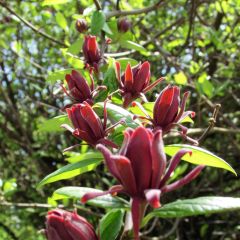
Calycanthus floridus - Sweetshrub
- Flowering time June, July
- Height at maturity 2 m
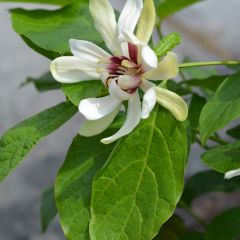
Calycanthus Venus- Sweetshrub
- Flowering time June to October
- Height at maturity 2 m
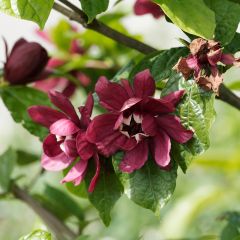
Calycanthus raulstonii Aphrodite- Sweetshrub
- Flowering time June to October
- Height at maturity 1,70 m
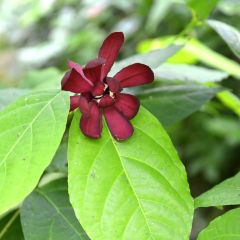
Calycanthus raulstonii Hartlage Wine- Sweetshrub
- Flowering time June to October
- Height at maturity 2 m
Discover other Calycanthus
Planting
Where to plant the Calycanthus?
With excellent hardiness, it can withstand very low temperatures of around -20°C, ensuring perfect resilience in all regions.
The Calycanthus needs warmth and light to flower. It’s best to protect it from cold winds, which could dry out its young shoots in spring and damage its flower buds: provide a sunny, preferably non-scorching and sheltered spot. In warmer regions, it can tolerate light shade.
Undemanding, the Calycanthus adapts to almost any soil type as long as it is deep, not too dry, and fairly rich. Even acidic soil, like heathland soil, will suit it. It will thrive best in slightly acidic soil that remains cool in summer but well-drained—it dislikes heavy, waterlogged soils in winter.
Think carefully about its location, as it dislikes being transplanted once well-established!
When mature, the Calycanthus won’t exceed 2m in height and can be used in a free hedge, mixed shrub or perennial borders, as a standalone near the house, or even in a pot on the terrace.
When to plant the Sweetshrub?
The Calycanthus should be planted in early spring after the last heavy frosts or in autumn, from September to November, to allow proper root development.
How to plant the Sweetshrub?
- In the ground
The soil should be well-worked in depth to accommodate the Calycanthus, which prefers well-draining soil where water doesn’t stagnate, especially in winter. Space plants about 1.20m apart. In heavy soil, lighten it with compost.
- Dig a hole at least 3 times wider than the root ball
- Loosen the soil well
- Ensure good drainage with river sand or gravel at the bottom of the hole
- Enrich half of the excavated soil with compost
- Plant the shrub with the root ball level with the ground (if needed, create a small mound to support the roots)
- Backfill, keeping the shrub upright, and lightly firm the soil
- Create a small watering basin
- Apply organic mulch to keep the base clean and cool in summer
- Water thoroughly with 2 watering cans after planting
- In pots
Calycanthus (x) raulstonii adapts well to container growing. The substrate should be rich and well-draining to avoid waterlogging at the roots. Repot every 2 or 3 years.
- Place a thick layer of drainage (gravel or clay pebbles) at the bottom of a pot at least 50cm in diameter
- Plant in quality shrub compost mixed with compost
- Mulch the base
- In summer, water well during flowering and when the soil dries out
→ Learn more about growing Calycanthus in pots in our guide!
Size and maintenance
Calycanthus requires little maintenance: a good organic mulch, some organic fertiliser and light pruning.
While the Sweetshrub adapts easily to all soil types, it prefers moist, not too dry soils.
In the first year, regular watering is essential. In summer, water once or twice a week during heatwaves. To keep the base cool during the growing season, apply a good organic mulch before spring, especially in the first few years after planting.
Calycanthus is a hungry plant that will appreciate annual compost applications each spring.
Pruning isn’t essential, except to reshape the silhouette as it matures, encourage new stem growth and rejuvenate the shrub.
- In late winter, around March-April, prune only every two or three years, thinning out the centre of the branches
- Cut back dead, weak or tangled stems by a quarter of their length
Diseases and potential pests
Hardy and resilient, the Calycanthus is not known to suffer from any diseases or specific pests.
Propagation
The simplest propagation method for the Sweet Shrub remains layering, to be carried out in late winter.
By Layering
While cuttings are possible, layering in spring is, in our opinion, the simplest method.
- Dig a shallow trench in the soil near the parent plant
- Choose a low-growing stem that can be easily bent to the ground
- Bury 1 or 2 nodes of woody growth about 20 centimetres deep
- Lift the leafy tip of the stem and stake this aerial portion
- Backfill the trench and secure the layer with a hook or stone
- Buds will root within 1 year: separate the layer from the parent plant when sufficiently rooted the following spring
- Cut the stem where it enters the ground to wean the layer
- Transplant immediately into open ground and water
Pairing
With a touch of sophistication, the Calycanthus is the star of any garden, bringing delicate flowers in abundance during spring and summer, along with originality, colour, and contrast. Whether as a striking focal point or mixed planting, it effortlessly enhances any setting. It’s a must-have for purple-themed gardens.
Stunning as a standalone feature in a strategic garden spot, it also works beautifully in a free-flowing, cottage-style hedge or within a large perennial and shrub border.
With its large anemone-like blooms in a lovely purple-magenta hue, it blends perfectly into natural gardens, alongside Dicentra formosa ‘Bacchanal’, perennial cinquefoils (‘Hopwoodiana’ or ‘Gibson’s Scarlet’), Papaver orientale ‘Patty’s Plum’ or Heucheras ‘Georgia Plum’ and ‘Forever Purple’, Salvia nemorosa ‘Amethyst’, or even a Lupin ‘West Country Masterpiece’ to create an exuberant pairing.
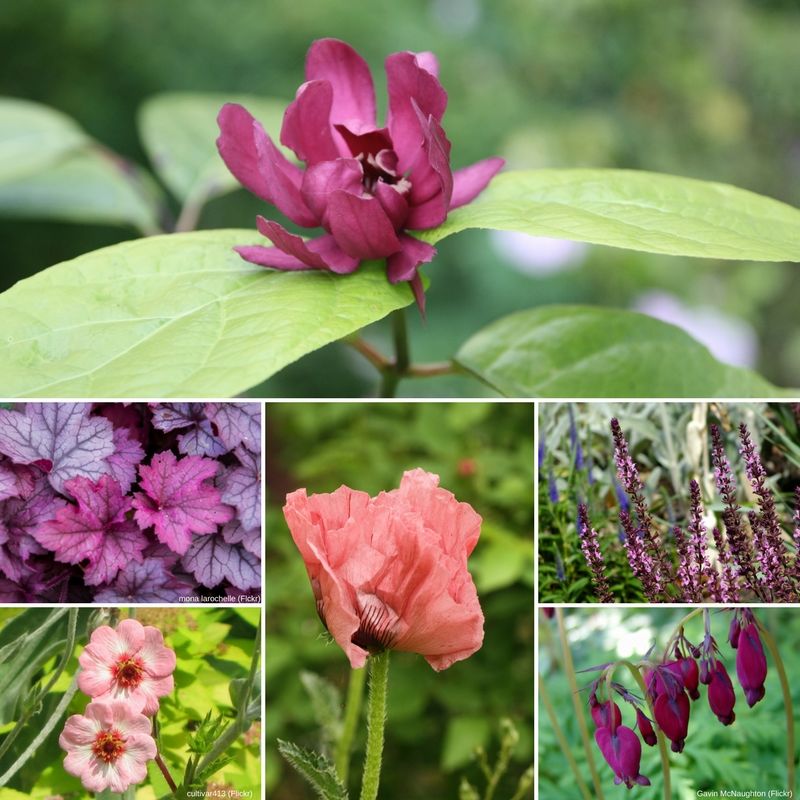

An example of a harmonious blend in shades of pink and purple: Calycanthus raulstonii ‘Hartlage Wine’ / Heuchera ‘Georgia Plum’ / Potentilla ‘Hopwoodiana’ / Papaver ‘Patty’s Plum’ / Salvia nemorosa ‘Amethyst’ / Dicentra formosa ‘Bacchanal’.
With its bushy silhouette and preference for slightly acidic soil, it will make a striking companion for heathland shrubs such as Andromedas, Magnolias, or tree peonies.
At the back of a border or in a flowering hedge, it pairs well with white or pink shrub roses, a Leycesteria formosa ‘Purple Rain’, Himalayan Honeysuckle, a Buddleja colvilei, a Cornus, or a Physocarpus.
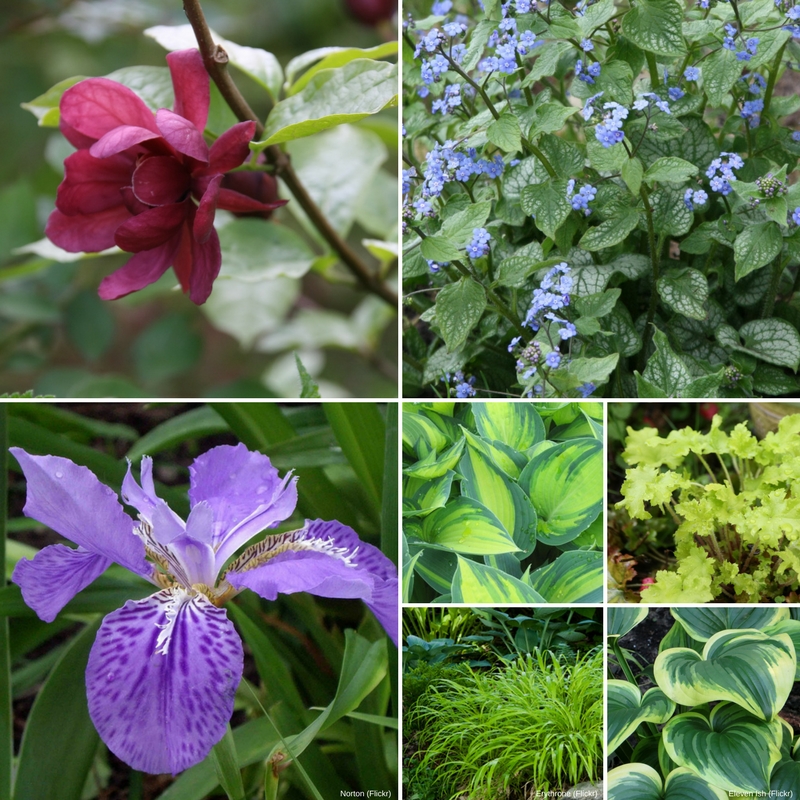

An example of a more contrasting pairing in a dappled woodland setting: Calycanthus raulstonii ‘Hartlage Wine’ / Brunnera macrophylla ‘Jack Frost’ / Iris tectorum / Hosta ‘June’ / Heuchera ‘Citronelle’ / Hakonechloa macra ‘AllGold’ / Hosta ‘Fragrant Dream’.
Useful resources
- Our exclusive Calycanthus varieties have arrived!
- Subscribe!
- Contents



































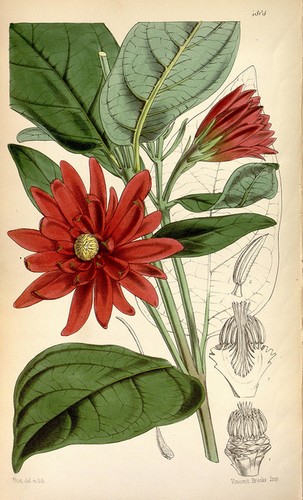


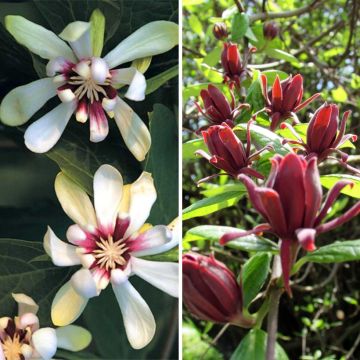



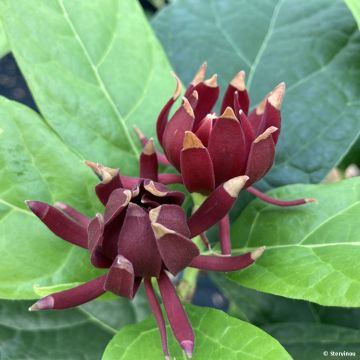
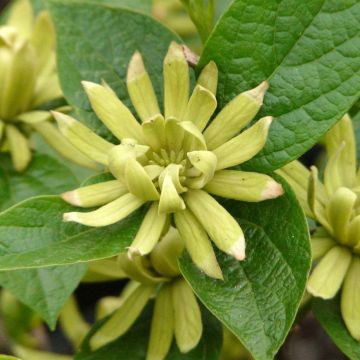
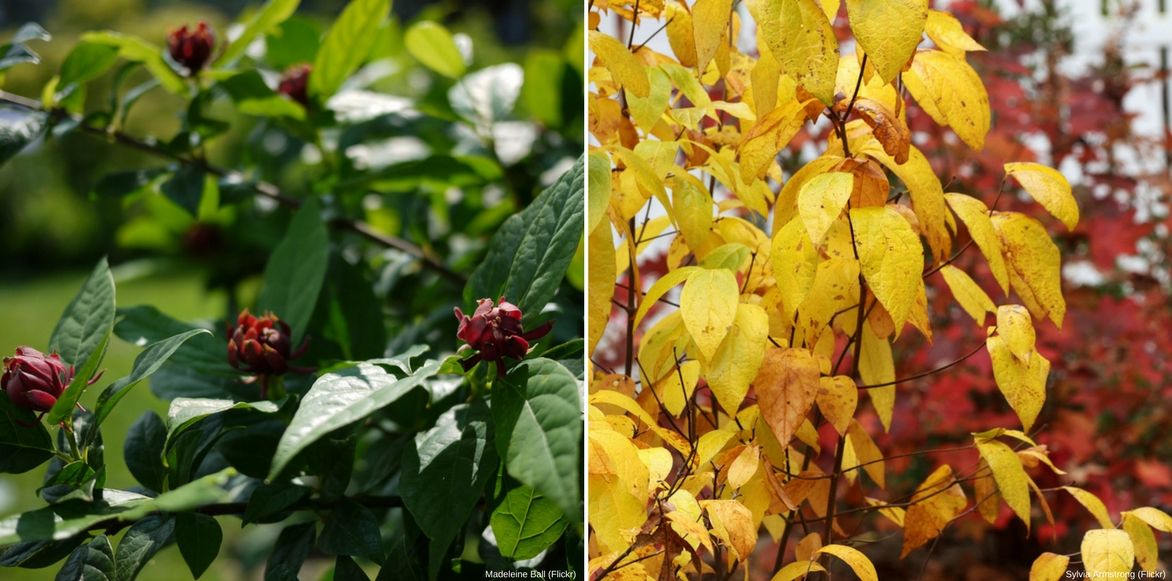
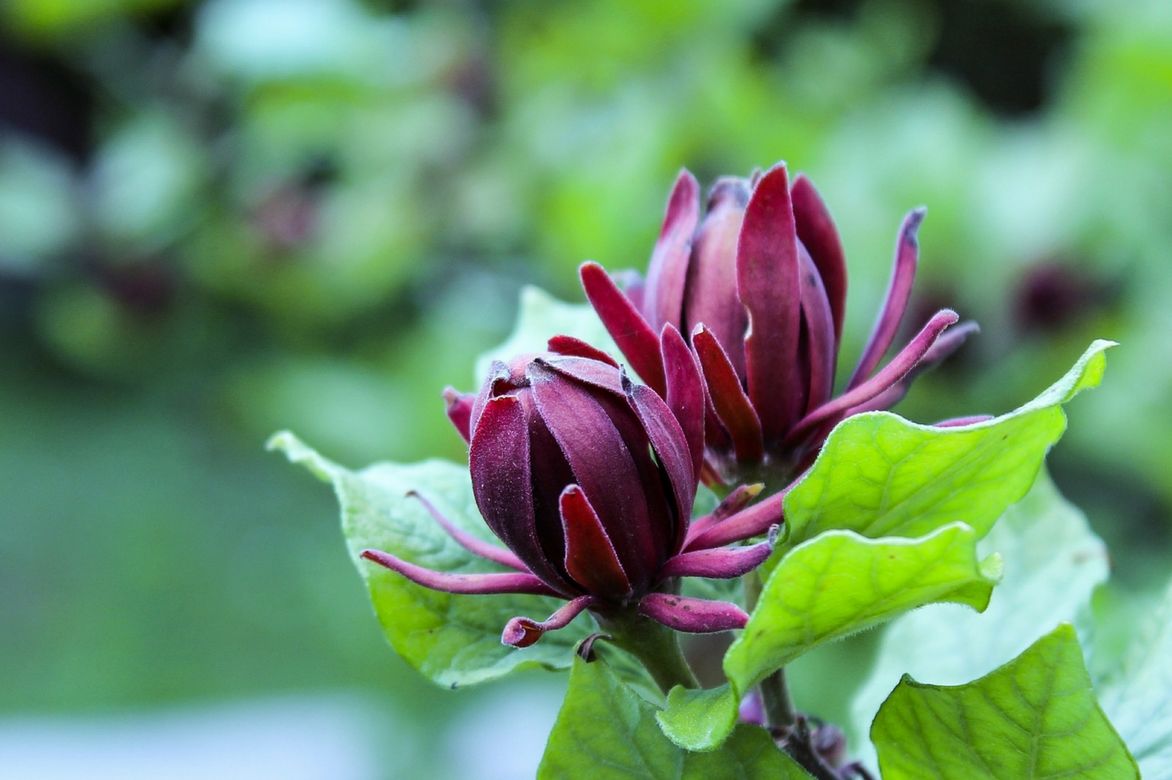
Comments